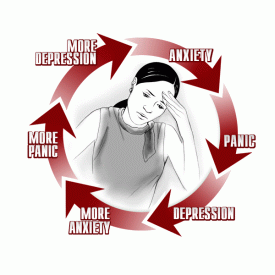Trypophobia and General Anxiety Disorder
Generalized Anxiety Disorder or GAD marks a chronic anxiety that can last for days, weeks and even months. Such patients feel constant concern, uncertainty about the future, fear of illness, general tension, and the tendency to rush to the minimum of stimulation, discomfort, and nervousness in working with people. The major symptom is anxiety, which occurs in many other psychiatric disorders such as bipolar disorder, psychotic disorder, personality disorder as well as psychological disorders caused by brain damage. These large groups of disorders are one of the most common psychological disorders and their frequency may vary from 0.05% for obsessive-compulsive disorder up to 5% for generalized anxiety disorder. One of the most important differences among them is the frequency of anxiety. In GAD, anxiety is almost always present while in some other disorder it occurs occasionally.

General Anxiety Disorder can cause Trypophobia
What causes GAD?
The onset of GAD symptoms is often associated with stressful events that weaken adaptive psychological mechanisms. It is believed that there are factors that create a tendency, i.e., predisposition to the occurrence of a generalized anxiety disorder. In the last decade, the importance of the genetic predisposition for GAD development is increasingly emphasized. Other predisposing factors are traumatic experiences during childbirth, especially in early childhood and of course personality traits. It is believed that people are prone to anxiety and worries before developing GAD. In addition to these factors, the occurrence of GAD symptoms is often associated with stressful events that weaken adaptive psychological mechanisms and increase the risk of various psychological disorders, including GAD. The patients develop problems in interpersonal relationships, workplace and family life, but also physical illnesses, especially those that are difficult. Continuous stress factors are also factors for maintaining this disorder, making it difficult to treat and recover. There are three major factors that contribute to the development of GAD:
– Genetics: Family history plays an important role in increasing the likelihood of a person to develop GAD. This means that the tendency to develop GAD may be passed on in families.
– Brain functioning: GAD has been associated with abnormal brain functions of certain nerve cells and neuron pathways involved in thinking and emotion. This nerve cell connections function on chemicals called neurotransmitters that transmit information from one nerve cell to the next. If the pathways that connect particular brain regions do not run efficiently, problems related to mood or anxiety may result.
– Environment: Life trauma and stressful events, such as abuse, the death of a family member or friend, divorce, changing jobs or schools, may contribute to GAD. The symptoms of GAD worsen during periods of stress.
Symptoms of GAD
The leading symptom of GAD is chronic anxiety which can last for a long time, sometimes even years. The patients experience physical symptoms such as a headache, dizziness, muscle pain, increased heart rate, trouble with breathing, the difficulty of swallowing, insomnia and many other dysfunctions. If the disorder lasts longer, depression and obsessive symptoms may also occur. Regarding the cognitive symptoms, they vary from the mild one to those which are severe. The most common cognitive symptoms are:
- Persistent worrying or anxiety about ordinary, life problems
- Constant overthinking and imagining possible worst-case outcomes
- Looking at situations and events as threatening, even when they are actually harmless
- Indecisiveness and constant fear of making the wrong decision
- Difficulties coping with uncertainty
- Inability to relax and perceive the reality as it is
- Difficulty concentrating, or the feeling that your mind “goes blank”
How is GAD diagnosed?
The doctor begins the evaluation by asking questions about the patient’s medical and psychiatric history and may perform a physical exam. Even though there are no lab tests to confirm this diagnosis, the doctor may use various tests to look for physical illness as the cause of symptoms. The doctors make their diagnosis on the basis of two major factors, the intensity and the duration of symptoms. The symptoms may interfere with daily living routine and affect the patient’s life quality, such as the inability to cope with everyday challenges such as work commitments, family obligations etc. Once the occurrence of the symptoms has been established, the doctor is able to find the right kind of therapy which may include medication and cognitive, behavioral and other types of therapy. GAD affects about 6.8 million American adults, including twice as many women as men. The disorder develops gradually and can begin at any point in the life cycle, but usually develops between childhood and middle age.
Treatment

General Anxiety Disorder worries Trypophobes
Once the doctor evaluates the patient’s psychical health, the patient may be referred to a psychiatrist or psychologist for a further evaluation of symptoms. These mental health professionals are trained to diagnose and discover the right kind of treatment for different types of anxiety disorders, GAD included. The treatment of GAD usually involves the use of medications and psychological therapies. Drugs are especially helpful for people whose symptoms are interfering and highly affecting the daily functioning. The dosage may vary, however, the most important thing is that they are used in the short-term (since they can develop addiction and interfere with memory and attention). These medications are referred to as benzodiazepines, sedative-hypnotics or “minor tranquilizers” because they can remove intense feelings of acute anxiety. (Xanax, Valium, Ativan, etc.) They work by decreasing the physical symptoms of anxiety, such as muscle tension and restlessness. In addition, patients suffering from anxiety disorders often participate in cognitive behavioral therapy, in which they learn to recognize and change thought patterns and behaviors that lead to anxious feelings. They also learn how to use relaxation techniques such as deep breathing and muscle relaxation and other appropriate therapies.
Trypophobia – how is it linked to GAD?
If we want to understand how GAD is connected with the development of Trypophobia, we need to understand the difference between a phobia and anxiety. Even though these psychological processes develop similar responses to certain dangers and some symptoms may overlap, the patient’s experience differs based on the context. These differences can account for how we react to various stressors from our environment. Phobias are usually treated as a type of anxiety disorder connected to our response to danger, which sometimes may be intense and irrational. Scientists believe that these symptoms result from an inborn fight-or-flight stress response necessary for our survival. Our mind receives the alerting danger signal and our bodies prepare to run away or face with danger. The simplest definition is that a phobia is a fear of a real, existing situation or objects and can be very specific while anxiety is the sense of feeling worried, irritable, unable to focus, etc. Sometimes the phobias do not just include an intense feeling of fear, but also irrational or extreme fear or one particular object or situation.

Trypophobia and the General Anxiety Disorder cycle
Trypophobia or the fear of the cluster of holes, bumps and similar patterns affects around 15% of the general population. Some researchers suggest that the origin of this phobia in an ingrained evolutionary instinct developed as a response to danger and hole-covered formations in nature. Among the first researchers to study this fear were psychological scientists Arnold J. Wilkins and Geoff Cole of the University of Essex. To understand the full scope of their research, we need to dig deep into the symptoms of Trypophobes. In an interview for International Business Times, the researchers stated that: “Holes have shadows. The cluster of holes with shadows provides an image with properties that are intrinsically uncomfortable by virtue of their spatial arrangement of high contrasts. They differ from most natural images (which the brain processes relatively efficiently) in that they have maximum contrast at spatial scales that the visual system is most sensitive to. In other words, they are physiologically strong stimuli. There is often (but not always) a history of an incident, often in childhood, which began the phobia. For example, I heard a story from someone who was stung by bees and became averse to honeycombs and other similar shapes.” The researchers have emphasized that Trypophobic triggers are strong psychological stimuli which can sometimes, only through remembering the dangerous situations, cause the development of anxiety and depression over time. The patients develop symptoms just by thinking about patterns of holes, even though they may seem as harmless and nor life-threatening.
In another research developed from a case report of a 12-year old girl, Martinez-Aguayo and his colleagues explained that the girl was first diagnosed with GAD and was treated with sertraline. In her initial diagnosis, she displayed “symptoms of both fear and disgust towards Trypophobic images”. Strong emotions of fear and disgust overlapped with the symptoms of anxiety such as dizziness, nausea, insomnia, increased heart rate etc. They resulted from harmless objects such as food items to remodeled walls and sidewalk embedded in it. The case was further on explained when the girl’s mother, who is a divorcee, experienced symptoms of GAD herself. Based on the information provided by the authors of the Frontiers article, there is some variance in the emotional responses of individuals with Trypophobia. “Research indicates that some people react with extreme fear and disgust while others react only with disgust,” Petersen explained.
However, from the psychological perspective, the phobia symptoms start as a response to real-life objects and experiences which may overlap with anxiety symptoms over time and become irrational and imaginary in some situations.
References
https://www.webmd.com/anxiety-panic/guide/generalized-anxiety-disorder#1
https://www.mayoclinic.org/diseases-conditions/generalized-anxiety-disorder/symptoms-causes/syc-20360803
https://www.psychologytoday.com/us/conditions/generalized-anxiety-disorder
https://www.ncbi.nlm.nih.gov/pubmedhealth/PMH0096637/pdf/PubMedHealth_PMH0096637.pdf
https://www.frontiersin.org/articles/10.3389/fpsyt.2018.00015/full
https://www.ncbi.nlm.nih.gov/pubmed/28423069
http://www.ibtimes.com/what-trypophobia-american-horror-story-triggers-rare-condition-fear-holes-2597702

